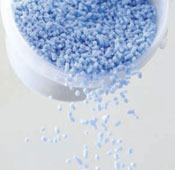Recently, a fast food outlet in the US was exposed using a plasticenhancing chemical additive in several food items. This has made plastic additives a health villain in the eyes of the public. Yet for the plastics industry, additives are “heroes”, since the enhancers provide throngs of excellent properties to conventional plastics to serve a broader range of applications, says Angelica Buan in this report.

The chemical compound azodicarbonamide (ADCA), which is used as a blowing agent to enhance the elasticity of foamed plastics for yoga mats and shoes, is also used as a food additive, as a flour bleaching and improving agent. Though permitted in the US and Canada, at levels up to 45 ppm, it is banned in Australia and Europe. Its usage in food products has suddenly been highlighted, with plastic additives becoming an issue as hot as the plastic bag ban.
Meanwhile, based on the current discussion about ADCA and new regulations aiming to improve indoor air quality, new “kickers” or activators are required to ensure that the level of ADCA in the final product does not exceed the limit of 0.1%. Taking this lead, German firm Baerlocher has introduced a new generation of low-VOC “kickers” for foamed PVC.
It has been shown to reduce organic emissions and fogging effects, helping manufacturers of automotive components, flooring, and wall coverings. “Kickers” can raise or lower the decomposition temperature of chemical foaming agents (CFAs) and also serve as stabilisers. Based on mixed-metals, the activators support the industry to meet the requirements set by REACH and ISO16000 and conform to Germany’s AgBB and France’s Emissions dans l’air interieur regulations.
Market growth envisaged
Based on the latest technical research by BCC Research, the additives market will witness an accelerated use of the chemical enhancers. The value will, thus, rise from US$43.4 billion in 2013 to an estimated US$47.7 billion in 2015. The sector is anticipated to grow to nearly US$60.3 billion by 2020, and post a five-year compound annual growth rate (CAGR) of 4.8% from 2015 to 2020, according to the study.
Nevertheless, the safety concerns attributed to plastics use often cascade to the raw material components, including additives. In cases when human health and environment-related risks are highlighted, the plastics industry bears the brunt, of either replacing the additives or proving that the additives used are harmless, says the study.
Shifting trends in the stabiliser market
Replacements are happening, especially in heat and light stabilisers that are used to ensure safe processing and to protect products against premature ageing and weathering, for PVC pipes/profiles and other building products.
At present, the global market for stabilisers is undergoing highly dynamic changes as the market shares of individual product groups are shifting considerably, says a study by research firm Ceresana. Holding a market share of 55%, Asia Pacific is the largest sales market for stabilisers globally, followed by Western Europe.
Meanwhile, the increasing substitution of lead-based stabilisers for calcium or tin have seen some suppliers divesting their stabiliser businesses to smaller companies specialised in the production of speciality chemicals. Ceresana forecasts the value of the global market for stabilisers to increase to US$5.3 billion in 2021.
Figuring largely in stabilisers are compounds based on calcium (calciumzinc and organo-calcium), lead and tin stabilisers as well as liquid and light stabilisers (HALS, benzophenone, benzotriazole). After cadmium-based products disappeared almost completely from the market over the last decade, recent years have seen an increasing substitution of lead-based products as well as a shift from the more expensive tin-based ones, especially in Europe and China. Ceresana expects global consumption of calcium-based stabilisers to increase by 6.9% per year.
Meanwhile, South Korean Songwon Industrial Group, the second largest manufacturer of polymer stabilisers globally, says that its Songxtend line solves a number of key issues encountered during processing, conversion and the end-use life cycle of polyolefins. Included are the 1101 and 1102 general purpose packages that allow PP producers and processors to maintain high temperature manufacturing while safeguarding the desired properties of the polymer as well as avoiding degradation and discolouration under severe processing conditions. Stability is assured from reactor to extruder where high heat and shear are often encountered.
Meanwhile, the 2121, 2122 and 2123 packages are designed for the automotive industry and are tailored to address fogging and odour issues in car interiors, reducing VOC emissions and improving organoleptic properties by either eliminating or reducing undesirable odours that negatively impact car interiors.
Reinforcing safety in composites
If additives in food have the potential to cause health risks, there are additives that warrant safety, too. These are the additives that reinforce flame retardant properties in conventional plastics.

Switzerland-based speciality chemicals company Clariant has launched Exolit AP ammonium polyphosphate-based and Exolit OP phosphinatebased for thermoset systems to support the aviation, road, rail and shipping sectors. Advantages lie in the effectiveness for composites and laminates, which enables low concentrations to be used.
Available for sole use or as synergistic formulations with aluminium hydroxide (ATH), Exolit AP enables thermoset resins used in fibreglassreinforced composites to reach high flammability requirements and meet fire standards, such as the new EU railway standard EN45545-2 for interiors, comprising the Hazard Level (HL) 2 and 3 requirements.
Composites with the flame retardants are also said to show advantages in smoke toxicity measurements (EN ISO 5659-2) and have in addition low heat release rates. In addition, Exolit grades can be used to formulate intumescent (gel)-coats, to improve the fire endurance of the whole composite part. The additives are suited for traditional hand layup, pultrusion and other techniques.
In related news, the Unité Matériaux et Transformations (UMET) at the University of Lille in France, is undertaking research with Clariant to show that it is possible to use Exolit to achieve flame retardancy for oyster shell reinforced-PP composites.
Eurostar Engineering Plastics is the developer of the “green” PP compound. By employing oyster shells as a source of mineral filler, it avoids the environmental disadvantages and high energy consumption of standard mining processes, and contributes to landfill reduction through recycling. In addition to oyster shells, research is also being undertaken on the viability of achieving flame retardancy with flax fillers.
Augmenting limitations in films
Plastics are not infallible materials: they break, stain or get scratched. Croda Polymer Additives has addressed some limitations by introducing a slip additive that uses new technology to combine the anti-friction benefits of erucamide with the stability benefits of behenamide. The saturated fatty acid amide is said to provide slip levels not achieved by other saturated slip additives commercially used.
While traditional slip additives improve film and sheet processing and handling, heat and UV exposure can break down the additives, compromising feel, odour and taste, Croda explains. The UK firm says its Incroslip SL provides slip performance, offers long-term stability against changes in taste and colour in consumer film and sheet as well as anti-scratch and low-blooming properties for automotive applications.
Meanwhile, Canadian supplier Trinity Resources has introduced a mineral-based anti-block additive for film production that it says combines the best properties of conventional minerals such as talc and nepheline syenite.
Altiblock is an alternative anti-block made from Trinity’s pyrophyllite deposits in Newfoundland, Canada. The mineral is a hydrous aluminium silicate that offers talc-like plate particles and irregular shapes for high blocking performance, clarity, film strength, barrier resistance and thermal efficiency.

Lift for recycled material
American firm Struktol has new additives designed to boost processing efficiency and performance for plastics containing recycled materials. TR229 is aimed at recycling applications for PC, PC/ABS blends and nylon 6 and 6.6. It also is suited for FDA-approved uses. TR219 for nylon 6 and 6.6, is also effective in PET compounds, especially for recycling where PET is contaminated with other plastics.
The two new products combine a compatibiliser and lubricants that help incorporate mineral or glass fillers through improved mixing and flow properties. Struktol says the additives also improve mould release properties, improve surface quality and in some cases bolster physical properties. The new additives complement Struktol’s existing lubricant-based products suited to support recycling and use of regrind for a range of polymers.
Since PET has the characteristics for exceptional recyclability, it is the most recycled plastic in the industry. Thus, enhancing further the recyclability of PET, liquid colour and additives specialist ColorMatrix has introduced its patented Joule RHB liquid infra-red absorption technology.
By adding this technology to bottle preforms, processors are able to reduce energy consumption by up to 30%, compared with reheat-free PET resin for production cost savings, says the firm. The additve provides energy gains and raw material savings throughout multiple processing steps by improving infra-red energy absorption. According to ColorMatrix, which is a subsidiary of PolyOne, the use of its inorganic, titanium nitride (TiN) means the additive can naturally withstand higher temperatures. Inherent blue toning properties help reduce the appearance of yellowing to maintain clarity, while the additive also retains its reheat capability after long-term recycling.
The formulation is manufactured at the firm’s Suzhou plant and is expected to support manufacturers in China and Asia, especially since it has been recently approved for PET food contact applications in China, up to a level of 20 ppm, and for temperature conditions equal to the US FDA’s condition of hot fill use up to 100°C.
(PRA)

















